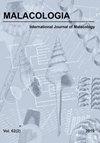辐射珠贝的非整倍性(Leach, 1814):海洋双壳类非随机染色体丢失和获得的证据
IF 1
4区 生物学
Q4 ZOOLOGY
引用次数: 0
摘要
非整倍体,或存在异常数目的染色体,已普遍观察到在海洋双壳类。这种现象也被证明与几种牡蛎和蛤蜊的生长和存活率呈负相关。污染物对双壳类非整倍体水平的影响先前也已得到证实。在过去的二十年中,已经证实了非随机染色体丢失的证据,在一些物种中报道了非整倍体核型中缺失染色体的鉴定。结果表明,在不同种类的牡蛎和蛤中,只有少数对优先受到同源染色体丢失的影响。最近,在对卡塔尔海洋环境的遗传毒性评估中,我们以平珠牡蛎(Pinctada radiata, Leach, 1814)为模型和替代种,观察到次二倍体和超二倍体核型。高二倍体更为常见,这在双壳类动物中是非常罕见的。对非整倍体细胞中额外和缺失的染色体的鉴定表明,4、5、12和13对染色体比其他染色体更容易受到额外个体染色体的影响。同一组对表现出失去一条同源染色体的趋势。本文讨论了双壳类动物染色体优先易感性的几种假设。本文章由计算机程序翻译,如有差异,请以英文原文为准。
Aneuploidy in the Pearl Oyster Pinctada radiata (Leach, 1814): Evidence for Nonrandom Chromosome Loss and Gain in Marine Bivalves
ABSTRACT Aneuploidy, or presence of an abnormal number of chromosomes, has been commonly observed in marine bivalves. This phenomenon has also been shown to be negatively correlated with growth and survival rates in several species of oysters and clams. The impact of pollutants on the aneuploidy level in bivalves has also been previously demonstrated. Over the past two decades, evidence of nonrandom chromosomal loss has been demonstrated, with the identification of the missing chromosomes in aneuploid karyotypes reported in several species. The results have shown that only a few pairs were preferentially affected by the loss of one homologue chromosome in different species of oysters and clams. Recently, during the genotoxicity assessment of the marine environment in Qatar using the pearl oyster Pinctada radiata (Leach, 1814) as model and surrogate species, we observed hypodiploid and hyperdiploid karyotypes. Hyperdiploidy was more frequent, which is highly uncommon in bivalves. The identification of the extra and missing chromosomes in aneuploid cells showed that pairs 4, 5, 12, and 13 were found to be more susceptible than others in having an extra individual chromosome. The same set of pairs showed a tendency to lose one homologue chromosome. Several hypotheses on the preferential chromosomal susceptibility in bivalves, in general, are discussed.
求助全文
通过发布文献求助,成功后即可免费获取论文全文。
去求助
来源期刊

Malacologia
生物-动物学
CiteScore
2.00
自引率
0.00%
发文量
15
审稿时长
3 months
期刊介绍:
Malacologia publishes papers on all groups of the Mollusca. Malacologia specializes in publishing long papers and monographic treatments. Complete data are especially appreciated. Papers must be of interest to an international readership. Papers in systematics, ecology, population ecology, genetics, molecular genetics, evolution and phylogenetic treatments are especially welcomed. Also welcomed are letters to the editor involving papers published or issues of import to science of the day.
 求助内容:
求助内容: 应助结果提醒方式:
应助结果提醒方式:


